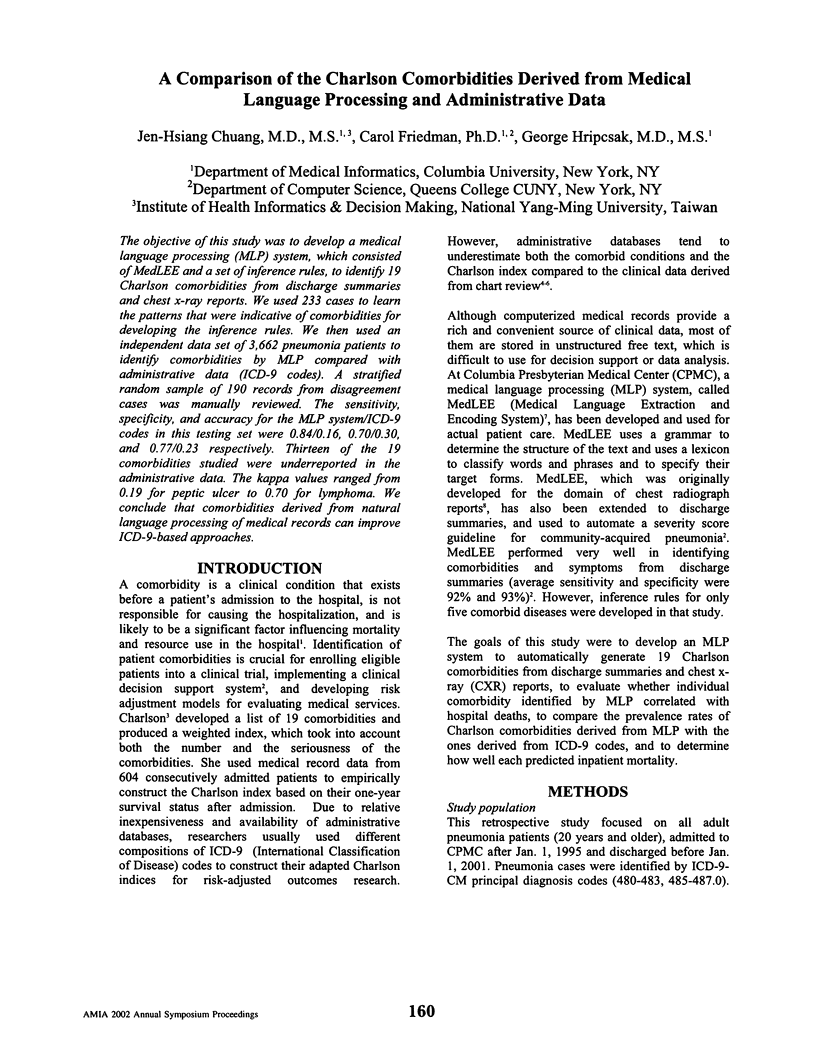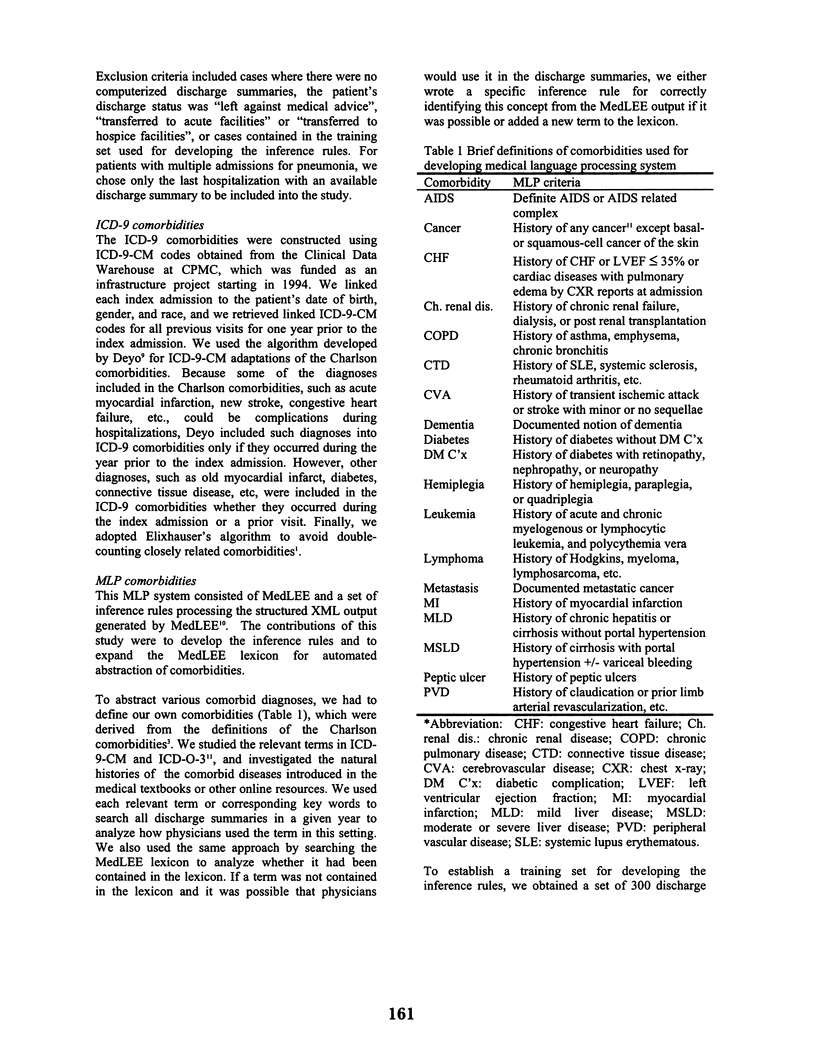Abstract
The objective of this study was to develop a medical language processing (MLP) system, which consisted of MedLEE and a set of inference rules, to identify 19 Charlson comorbidities from discharge summaries and chest x-ray reports. We used 233 cases to learn the patterns that were indicative of comorbidities for developing the inference rules. We then used an independent data set of 3,662 pneumonia patients to identify comorbidities by MLP compared with administrative data (ICD-9 codes). A stratified random sample of 190 records from disagreement cases was manually reviewed. The sensitivity, specificity, and accuracy for the MLP system/ICD-9 codes in this testing set were 0.84/0.16, 0.70/0.30, and 0.77/0.23 respectively. Thirteen of the 19 comorbidities studied were underreported in the administrative data. The kappa values ranged from 0.19 for peptic ulcer to 0.70 for lymphoma. We conclude that comorbidities derived from natural language processing of medical records can improve ICD-9-based approaches.
Full text
PDF




Selected References
These references are in PubMed. This may not be the complete list of references from this article.
- Charlson M. E., Pompei P., Ales K. L., MacKenzie C. R. A new method of classifying prognostic comorbidity in longitudinal studies: development and validation. J Chronic Dis. 1987;40(5):373–383. doi: 10.1016/0021-9681(87)90171-8. [DOI] [PubMed] [Google Scholar]
- DeLong E. R., DeLong D. M., Clarke-Pearson D. L. Comparing the areas under two or more correlated receiver operating characteristic curves: a nonparametric approach. Biometrics. 1988 Sep;44(3):837–845. [PubMed] [Google Scholar]
- Deyo R. A., Cherkin D. C., Ciol M. A. Adapting a clinical comorbidity index for use with ICD-9-CM administrative databases. J Clin Epidemiol. 1992 Jun;45(6):613–619. doi: 10.1016/0895-4356(92)90133-8. [DOI] [PubMed] [Google Scholar]
- Elixhauser A., Steiner C., Harris D. R., Coffey R. M. Comorbidity measures for use with administrative data. Med Care. 1998 Jan;36(1):8–27. doi: 10.1097/00005650-199801000-00004. [DOI] [PubMed] [Google Scholar]
- Friedman C., Alderson P. O., Austin J. H., Cimino J. J., Johnson S. B. A general natural-language text processor for clinical radiology. J Am Med Inform Assoc. 1994 Mar-Apr;1(2):161–174. doi: 10.1136/jamia.1994.95236146. [DOI] [PMC free article] [PubMed] [Google Scholar]
- Friedman C., Hripcsak G., Shagina L., Liu H. Representing information in patient reports using natural language processing and the extensible markup language. J Am Med Inform Assoc. 1999 Jan-Feb;6(1):76–87. doi: 10.1136/jamia.1999.0060076. [DOI] [PMC free article] [PubMed] [Google Scholar]
- Friedman C., Knirsch C., Shagina L., Hripcsak G. Automating a severity score guideline for community-acquired pneumonia employing medical language processing of discharge summaries. Proc AMIA Symp. 1999:256–260. [PMC free article] [PubMed] [Google Scholar]
- Ghali W. A., Hall R. E., Rosen A. K., Ash A. S., Moskowitz M. A. Searching for an improved clinical comorbidity index for use with ICD-9-CM administrative data. J Clin Epidemiol. 1996 Mar;49(3):273–278. doi: 10.1016/0895-4356(95)00564-1. [DOI] [PubMed] [Google Scholar]
- Giraud T., Dhainaut J. F., Vaxelaire J. F., Joseph T., Journois D., Bleichner G., Sollet J. P., Chevret S., Monsallier J. F. Iatrogenic complications in adult intensive care units: a prospective two-center study. Crit Care Med. 1993 Jan;21(1):40–51. doi: 10.1097/00003246-199301000-00011. [DOI] [PubMed] [Google Scholar]
- Hripcsak G., Friedman C., Alderson P. O., DuMouchel W., Johnson S. B., Clayton P. D. Unlocking clinical data from narrative reports: a study of natural language processing. Ann Intern Med. 1995 May 1;122(9):681–688. doi: 10.7326/0003-4819-122-9-199505010-00007. [DOI] [PubMed] [Google Scholar]
- Kieszak S. M., Flanders W. D., Kosinski A. S., Shipp C. C., Karp H. A comparison of the Charlson comorbidity index derived from medical record data and administrative billing data. J Clin Epidemiol. 1999 Feb;52(2):137–142. doi: 10.1016/s0895-4356(98)00154-1. [DOI] [PubMed] [Google Scholar]
- Le Gall J. R., Lemeshow S., Saulnier F. A new Simplified Acute Physiology Score (SAPS II) based on a European/North American multicenter study. JAMA. 1993 Dec 22;270(24):2957–2963. doi: 10.1001/jama.270.24.2957. [DOI] [PubMed] [Google Scholar]
- Lemeshow S., Hosmer D. W., Jr A review of goodness of fit statistics for use in the development of logistic regression models. Am J Epidemiol. 1982 Jan;115(1):92–106. doi: 10.1093/oxfordjournals.aje.a113284. [DOI] [PubMed] [Google Scholar]
- Malenka D. J., McLerran D., Roos N., Fisher E. S., Wennberg J. E. Using administrative data to describe casemix: a comparison with the medical record. J Clin Epidemiol. 1994 Sep;47(9):1027–1032. doi: 10.1016/0895-4356(94)90118-x. [DOI] [PubMed] [Google Scholar]
- McCarthy E. P., Iezzoni L. I., Davis R. B., Palmer R. H., Cahalane M., Hamel M. B., Mukamal K., Phillips R. S., Davies D. T., Jr Does clinical evidence support ICD-9-CM diagnosis coding of complications? Med Care. 2000 Aug;38(8):868–876. doi: 10.1097/00005650-200008000-00010. [DOI] [PubMed] [Google Scholar]
- Powell H., Lim L. L., Heller R. F. Accuracy of administrative data to assess comorbidity in patients with heart disease. an Australian perspective. J Clin Epidemiol. 2001 Jul;54(7):687–693. doi: 10.1016/s0895-4356(00)00364-4. [DOI] [PubMed] [Google Scholar]


